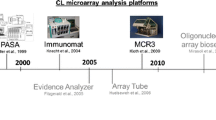Abstract
Pathogen detection is important for health and safety reasons. Several outbreaks all over the world have shown the need for rapid, qualitative, quantitative, and, particularly, multianalyte detection systems. Hence, a multichannel flow-through chemiluminescence microarray chip for parallel detection of pathogenic bacteria was developed. The disposable chip made of acrylonitrile–butadiene–styrene (ABS) copolymer was devised as a support for a multiplexed sandwich immunoassay. Calibration and measurement was possible in one experiment, because the developed chip contains six parallel flow-through microchannels. Polyclonal antibodies against the pathogenic bacteria Escherichia coli O157:H7, Salmonella typhimurium, and Legionella pneumophila were immobilized on the chip by microcontact printing in order to use them as specific receptors. Detection of the captured bacteria was carried out by use of specific detection antibodies labelled with biotin and horseradish peroxidase (HRP)–streptavidine conjugates. The enzyme HRP generates chemiluminescence after adding luminol and hydrogen peroxide. This signal was observed by use of a sensitive CCD camera. The limits of detection are 1.8 × 104 cells mL−1 for E. coli O157:H7, 7.9 × 104 cells mL−1 for L. pneumophila, and 2.0 × 107 cells mL−1 for S. typhimurium. The overall assay time for measurement and calibration is 18 min, enabling very fast analysis.

Array principle





Similar content being viewed by others
References
Ivnitski D, Abdel-Hamid I, Atanasov P, Wilkins E (1999) Biosens Bioelectron 14:599–624
Seidel M, Niessner R (2008) Anal Bioanal Chem 391:1521–1544
Iqbal SS, Mayo MW, Bruno JG, Bronk BV, Batt CA, Chambers JP (2000) Biosens Bioelectron 15:549–578
Anthony RM, Schuitema ARJ, Oskam L, Klatser PR (2005) J Microbiol Methods 60:47–54
Donhauser CM, Niessner R, Seidel M (2009) Anal Sciences 25:669–674
Lai RY, Lagally ET, Lee SH, Soh HT, Plaxco KW, Heeger AJ (2006) PNAS 103:4017–4021
Lim DV, Simpson JM, Kearns EA, Kramer MF (2005) Clin Microbiol Rev 18:583–607
Lazcka O, Del Campo FJ, Munoz FX (2007) Biosens Bioelectron 22:1205–1217
Stratis-Cullum DN, Griffin GD, Mobley J, Vo-Dinh T (2008) Anal Bioanal Chem 391:1655–1660
Rowe-Taitt CA, Golden JP, Feldstein MJ, Cras JJ, Hoffman KE, Ligler FS (2000) Biosens Bioelectron 14:785–794
Wolter A, Niessner R, Seidel M (2008) Anal Chem 80:5854–5863
Bally M, Dhumpa R, Voros J (2009) Biosens Bioelectron 24(5):1195–1200
Shriver-Lake LC, Ligler FS (2005) IEEE Sens Journal 5:751–756
Rowe CA, Tender LM, Feldstein MJ, Golden JP, Scruggs SB, MacCraith BD, Cras JJ, Ligler FS (1999) Anal Chem 71:3846–3852
Dunbar SA, Vander Zee CA, Oliver KG, Karem KL, Jacobson JW (2003) J Microbiol Methods 53:245–252
Liepold P, Kratzmueller T, Persike N, Bandilla M, Hinz M, Wieder H, Hillebrandt H, Ferrer E, Hartwich G (2008) Anal Bioanal Chem 391:1759–1772
Elsholz B, Nitsche A, Achenbach J, Ellerbrok H, Blohm L, Albers J, Pauli G, Hintsche R, Worl R (2009) Biosens Bioelectron 24:1737–1743
Elsholz B, Worl R, Blohm L, Albers J, Feucht H, Grunwald T, Jurgen B, Schweder T, Hintsche R (2006) Anal Chem 78:4794–4802
Huelseweh B, Ehricht R, Marschall HJ (2006) Proteomics 6:2972–2981
Magliulo M, Simoni P, Guardigli M, Michelini E, Luciani M, Lelli R, Roda A (2007) J Agric Food Chem 55:4933–4939
Wolter A, Niessner R, Seidel M (2007) Anal Chem 79:4529–4537
Kloth K, Niessner R, Seidel M (2009) Biosens Bioelectron 24:2106–2112
Kloth K, Rye-Johnsen M, Didier A, Dietrich R, Märtlbauer E, Niessner R, Seidel M (2009) Analyst 134:1433–1439
Kusnezow W, Jacob A, Walijew A, Diehl F, Hoheisel JD (2003) Proteomics 3:254–264
Seidel M, Gauglitz G (2003) Trends Anal Chem 22:385–394
Oh BK, Lee W, Chun BS, Bae YM, Lee WH, Choi JW (2005) Biosens Bioelectron 20:1847–1850
Taitt CR, Shubin YS, Angel R, Ligler FS (2004) Appl Environ Microbiol 70:152–158
Peskoller C, Niessner R, Seidel M (2009) Anal Bioanal Chem 393:399–404
Peskoller C, Niessner R, Seidel M (2009) J Chromatogr A 1216:3794–3801
Acknowledgments
We gratefully thank York Karsunke (Softwarebüro Karsunke, Wolnzach, Germany) for the free license of SIP 0.4. Special thanks to Sebastian Wiesemann for the fabrication of the readout system and the ABS chips. We also thank Dr Sören Schubert from the Max-Pettenkofer-Institut (Munich, Germany) and Dr Rossella Lelli from the Instituto Zooprofilattico Sperimentale Dell’Abruzzo (Italy) for the heat-inactivated bacteria and Adhesive Research Ireland Ltd (Limerick, Ireland) for the adhesive film.
Author information
Authors and Affiliations
Corresponding author
Rights and permissions
About this article
Cite this article
Karsunke, X.Y.Z., Niessner, R. & Seidel, M. Development of a multichannel flow-through chemiluminescence microarray chip for parallel calibration and detection of pathogenic bacteria. Anal Bioanal Chem 395, 1623–1630 (2009). https://doi.org/10.1007/s00216-009-2905-7
Received:
Revised:
Accepted:
Published:
Issue Date:
DOI: https://doi.org/10.1007/s00216-009-2905-7




